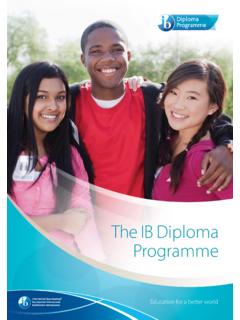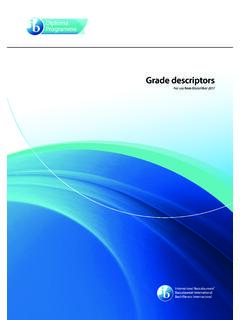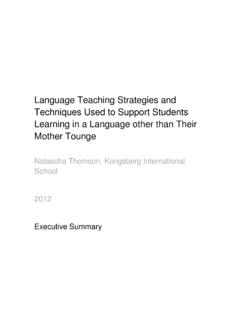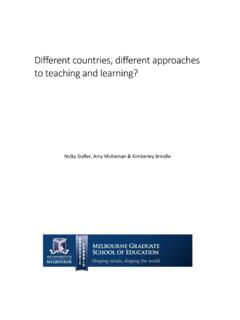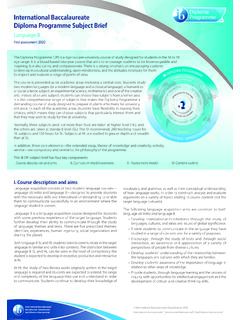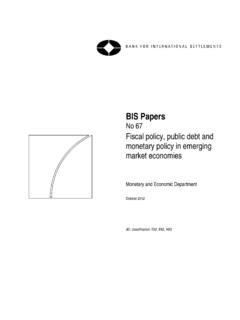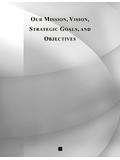Transcription of International Baccalaureate Diploma Programme Subject Brief
1 The Diploma Programme (DP) is a rigorous pre-university course of study designed for students in the 16 to 19 age range. It is a broad-based two-year course that aims to encourage students to be knowledgeable and inquiring, but also caring and compassionate. There is a strong emphasis on encouraging students to develop intercultural understanding, open-mindedness, and the attitudes necessary for them to respect and evaluate a range of points of view. The course is presented as six academic areas enclosing a central core. Students study two modern languages (or a modern language and a classical language), a humanities or social science Subject , an experimental science, mathematics and one of the creative arts. Instead of an arts Subject , students can choose two subjects from another area. It is this comprehensive range of subjects that makes the Diploma Programme a demanding course of study designed to prepare students effectively for university entrance.
2 In each of the academic areas students have flexibility in making their choices, which means they can choose subjects that particularly interest them and that they may wish to study further at university. Normally, three subjects (and not more than four) are taken at higher level (HL), and the others are taken at standard level (SL). The IB recommends 240 teaching hours for HL subjects and 150 hours for SL. Subjects at HL are studied in greater depth and breadth than at SL. In addition, three core elements the extended essay, theory of knowledge and creativity, activity, service are compulsory and central to the philosophy of the Programme . These DP Subject briefs illustrate four key course components. I. Course description and aims II. Curriculum model overview III. Assessment model IV. Sample questionsInternational Baccalaureate Diploma Programme Subject Brief Individuals and societies: Economics higher levelFirst assessments 2022 last assessments 2029 International Baccalaureate Organization 2020 International Baccalaureate | Baccalaur at International | Bachillerato Internacional I.
3 Course description and aimsEconomics is an exciting, dynamic Subject that allows students to develop an understanding of the complexities and interdependence of economic activities in a rapidly changing world. At the heart of economic theory is the problem of scarcity. Owing to scarcity, choices have to be made. The economics course, at both SL and HL, uses economic theories, models and key concepts to examine the ways in which these choices are made: at the level of producers and consumers in individual markets (microeconomics); at the level of the government and the national economy (macroeconomics); and at an International level, where countries are becoming increasingly interdependent (the global economy). The DP economics course allows students to explore these models, theories and key concepts, and apply them, using empirical data, through the examination of six real-world issues. Through their own inquiry, students will be able to appreciate both the values and limitations of economic models in explaining real-world economic behaviour and outcomes.
4 By focusing on the six real-world issues through the nine key concepts (scarcity, choice, efficiency, equity, economic well-being, sustainability, change, interdependence and intervention), students of the economics course will develop the knowledge, skills, values and attitudes that will encourage them to act responsibly as global aims of the DP economics course are to enable students to: zdevelop a critical understanding of a range of economic theories, models, ideas and tools in the areas of microeconomics, macroeconomics and the global economy zapply economic theories, models, ideas and tools, and analyse economic data to understand and engage with real-world economic issues and problems facing individuals and societies zdevelop a conceptual understanding of individuals and societies economic choices, interactions, challenges and consequences of economic Curriculum model overviewComponentRecommended teaching hoursUnit 1: Introduction to What is economics?
5 1. 2 How do economists approach the world?10 Unit 2: Microeconomics2 .1 Competitive market Critique of the maximizing behaviour of consumers and Elasticity of Elasticity of Role of government in Market failure externalities and common pool or common access Market failure public goods2 .10 Market failure asymmetric information 2 .11 Market failure market power2 .12 The market s inability to achieve equity70 Unit 3: Measuring economic activity and illustrating its Variations in economic activity aggregate demand and aggregate Macroeconomic Economics of inequality and Demand management (demand-side policies) monetary Demand management fiscal Supply-side policies75IB Diploma PROGRAMMEINTERNATIONAL MINDEDNESSMATHEMATICSAND LITERATUREINDIVIDUALS THEORY OF KNOWLEDGE EXTENDED ESSAY CREATIVITY, ACTIVITY, SERVICEAPPROACHES TO TEACHINGAPPROACHES TO LEARNINGSCIENCESSTUDIES IN LANGUAGEACQUISITIONTHE ARTSLANGUAGEAND SOCIETIESUnit 4: The global economy4.
6 1 Benefits of International Types of trade Arguments for and against trade Economic Exchange Balance of Sustainable Measuring Barriers to economic growth and/or economic development4 .10 Economic growth and/or economic development strategies65 Internal assessmentPortfolio of three commentaries20 III. Assessment modelThere are four assessment objectives for the DP economics course. Having followed the course at HL, students will be expected to meet the following objective 1: Knowledge and understanding zDemonstrate knowledge and understanding of specified content zDemonstrate knowledge and understanding of the common SL/HL syllabus zDemonstrate knowledge and understanding of current economic issues and data zDemonstrate knowledge and understanding of the HL extension topicsAssessment objective 2: Application and analysis zApply economic concepts and theories to real-world situations zIdentify and interpret economic data zAnalyse how economic information is used effectively in particular contexts zIn the internal assessment task: Explain the link between key economic concepts and economic commentaries zDemonstrate application and analysis of the HL extension topicsAssessment objective 3.
7 Synthesis and evaluation zExamine economic concepts and theories zUse economic concepts and examples to construct and present an argument zDiscuss and evaluate economic information and theories zDemonstrate economic synthesis and evaluation of the HL extension topics zSelect and use economic data using economic theory to make policy recommendationsAssessment objective 4: Use and application of appropriate skills zProduce well-structured written material, using appropriate economic theory, concepts and terminology zProduce and use diagrams to help explain economic theory, concepts and real-world issues zSelect, interpret and analyse appropriate extracts from the news media zInterpret appropriate data sets zUse quantitative techniques to identify, explain and analyse economic relationshipsType of assessmentFormat of assessmentTime Weighting of final grade (%)External4 hours 45 mins80 Paper 1 Extended response paper based on all units of the syllabus1 hour 15 mins20 Paper 2 Data response paper based on all units of the syllabus1 hour 45 mins30 Paper 3 policy paper based on all units of the syllabus1 hour 45 mins30 InternalPortfolioThree commentaries based on different units of the syllabus (except the introductory unit)
8 And from published extracts from the news media, analysed using different key concepts20 hours20IV. Sample questionsPaper 1 zExplain two tools open to a central bank to conduct expansionary monetary policy . zUsing real-world examples, evaluate the effectiveness of monetary policy to achieve low 2 zUsing an exchange rate diagram, explain how the increase in the interest rate by the Nigerian central bank might prevent the continued fall in the value of the 3 zUsing the data provided, and your knowledge of economics, recom-mend a policy that could be introduced by the government of Country X in response to the expected fall in the world price of the IB: For over 50 years, the IB has built a reputation for high-quality, challenging programmes of education that develop internationally minded young people who are well prepared for the challenges of life in the 21st century and are able to contribute to creating a better, more peaceful further information on the IB Diploma Programme , visit: Subject guides can be accessed through the Programme resource centre or purchased through the IB store.
9 For more on how the DP prepares students for success at university, visit.
